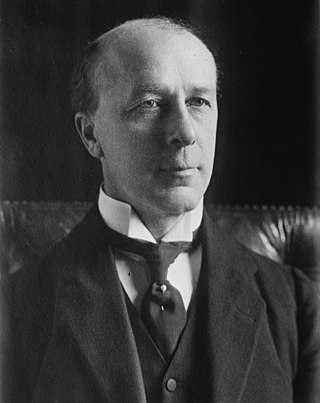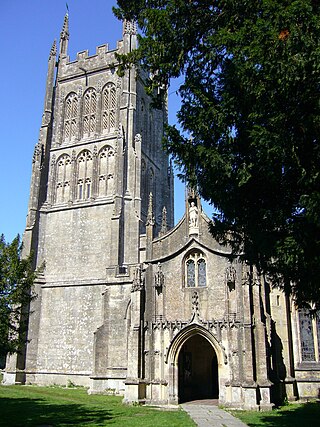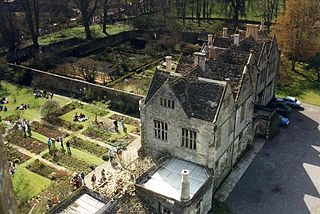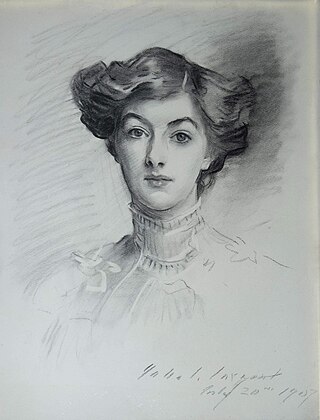
Raymond Herbert Asquith was an English barrister and eldest son of British prime minister H. H. Asquith. A distinguished Oxford scholar, he was a member of the fashionable group of intellectuals known as the Coterie, which included, Lady Diana Manners, Patrick Shaw-Stewart, Charles Lister, Hugo "Ego" Charteris, Julian Grenfell and Edward Horner. The Coterie were notable for their unconventional lifestyles and lavish hospitality. Like several of them, Asquith was killed in action in the First World War during his father's term in office.

Reginald McKenna was a British banker and Liberal politician. His first Cabinet post under Henry Campbell-Bannerman was as President of the Board of Education, after which he served as First Lord of the Admiralty. His most important roles were as Home Secretary and Chancellor of the Exchequer during the premiership of H. H. Asquith. He was studious and meticulous, noted for his attention to detail, but also for being bureaucratic and partisan.

Shapwick is a village on the Polden Hills overlooking the Somerset Moors, in Somerset, England. It is situated to the west of Glastonbury.

St Andrew's Church is a Church of England parish church located in the village of Mells in the English county of Somerset. The church is a grade I listed building.

Mells is a village and civil parish in Somerset, England, near the town of Frome.

Sir Edward Guy Dawber, RA was an English architect working in the late Arts and Crafts style, whose work is particularly associated with the Cotswolds.

Redlynch is a village and former manor in the civil parish of Bruton, in the South Somerset district of Somerset, England. The 18th-century church and a folly named The Towers are of architectural interest.

Melbury House is an English country house in the parish of Melbury Sampford near Evershot, Dorset. The Grade I listed mansion is the home of the Honorable Mrs Charlotte Townshend, a major landowner in east Dorset, through her mother, Theresa Fox-Strangways.

Mells Manor at Mells, Somerset, England, was built in the 16th century for Edward Horner, altered in the 17th century, partially demolished around 1780, and restored by Sir Edwin Lutyens in the 20th century. The house, along with the garden walls, has been designated as a Grade I listed building, and is closely associated with the adjacent Church of St Andrew. The gardens are listed, Grade I, on the Register of Historic Parks and Gardens of special historic interest in England.

Orchards is an Arts and Crafts style house in Bramley in Surrey, England. It is on Bramley's boundary with Busbridge and 1 mile (1.6 km) south-east of Godalming town centre. Described by English Heritage as the first major work of architect Edwin Lutyens, it is a Grade I listed building. The gardens are Grade II* listed in the National Register of Historic Parks and Gardens. The property is privately owned.

Heathcote is a Neoclassical-style villa in Ilkley, West Yorkshire, England. Designed by architect Edwin Lutyens, it was his first comprehensive use of that style, making it the precursor of his later public buildings in Edwardian Baroque style and those of New Delhi. It was completed in 1908.

Middleton Park is a rural park in the parish of Middleton Stoney, Oxfordshire, England, about 2+1⁄2 miles (4 km) west of Bicester. The grounds are Grade II listed and include several historic buildings, notably a Grade I listed country house with Grade II* listed service wing and lodges.

Marshcourt, also spelled Marsh Court, is an Arts and Crafts style country house in Marsh Court, near Stockbridge, Hampshire, England. It is constructed from quarried chalk. Designed and built by architect Edwin Lutyens between 1901 and 1905, it is a Grade I listed building. The gardens, designed by Lutyens and Gertrude Jekyll, are Grade II* listed in the National Register of Historic Parks and Gardens.

Mells War Memorial is a First World War memorial by Sir Edwin Lutyens in the village of Mells in the Mendip Hills of Somerset, south-western England. Unveiled in 1921, the memorial is one of multiple buildings and structures Lutyens designed in Mells. His friendship with two prominent families in the area, the Horners and the Asquiths, led to a series of commissions; among his other works in the village are memorials to two sons—one from each family—killed in the war. Lutyens toured the village with local dignitaries in search of a suitable site for the war memorial, after which he was prompted to remark "all their young men were killed".

The equestrian statue of Edward Horner stands inside St Andrew's Church in the village of Mells in Somerset, south-western England. It was designed by the architect Sir Edwin Lutyens, as a memorial to Edward Horner, who died of wounds in the First World War. The sculpture was executed by Sir Alfred Munnings.

Shapwick Manor at Shapwick in the county of Somerset, England, is a medieval manor house, largely remodelled in the 19th century by Henry Strangways on his return from South Australia in 1871.
Sir John Francis Fortescue Horner, was a British barrister. His family had lived at Mells Manor for generations and many have memorials in St Andrew's Church, Mells. He and his family became associated with The Souls, a social group which included many of the most distinguished English politicians and intellectuals of the Victorian era.

Frances Jane Horner, Lady Horner was a British hostess, member of the Souls social group, and a patron of the arts. She was depicted several times by Edward Burne-Jones, and commissioned works by Edwin Lutyens, Eric Gill, and William Nicholson. She was the impetus for Norah Lindsay beginning a paid career as a garden designer as her garden at Mells Manor was designed by Lindsay.

Katharine Frances Asquith was an English landowner and patron of the arts. During the First World War, she served as a Voluntary Aid Detachment nurse. She was the wife of Raymond Asquith and the daughter-in-law of wartime prime minister H. H. Asquith.

Mulberry House, Number 36, Smith Square, is located in the City of Westminster, London. It was built in 1911 as a private house for Reginald McKenna, a politician and later Chairman of the Midland Bank. The architect was Edwin Lutyens. In 1930 the house was bought by Henry Mond, 2nd Baron Melchett. In conjunction with his wife, Gwen, Melchett employed the architect Darcy Braddell to undertake a major internal remodeling and redecoration. Braddell engaged a number of painters and sculptors, including Charles Sargeant Jagger to create what has been described as "one of the most important Art Deco interiors in London." After a period of institutional use in the post-war period, the house was reconverted to a private residence in the early 21st century.



















